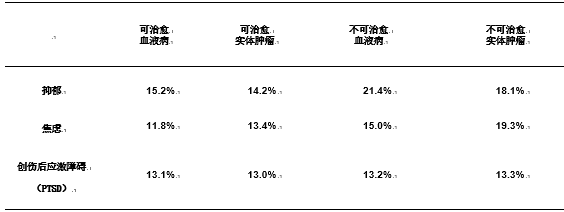点评:谢晓冬
可治愈和不可治愈的癌症住院患者中的症状负担分析

河北医科大学第四医院 肿瘤内科
河北省肿瘤内科诊疗中心
中国医疗保健国际交流促进会姑息治疗与人文关怀分会(CAHPC) 秘书
中国医药教育协会腹部肿瘤专业委员会 委员
背景
住院患者支持治疗干预措施主要针对自我感觉症状较重的晚期实体瘤患者。然而,很少有研究报道可治愈癌症住院患者的症状发生率。本研究目的在于描述和比较住院患者中可治愈和不可治愈癌症患者的症状负担和姑息治疗利用情况,以为支持性治疗资源分配提供依据。
方法
我们对2014年9月至2017年4月之间单中心1549例患者进行了研究(238例可治愈血液肿瘤,239例可治愈实体肿瘤,123例不可治愈血液肿瘤,949例不可治愈实体肿瘤)。入院时,我们评估了患者的躯体症状(Edmonton Symptom Assessment System)和心理痛苦(Patient Health Questionnaire-4 and Primary Care PTSD Screen)。
结果
可治愈血液肿瘤、可治愈实体肿瘤、不可治愈血液肿瘤、不可治愈实体肿瘤患者报告的中位中重度症状数分别为5 [3-6],5 [3-7],5 [4-6]和6 [4-7]。大多数患者报告了中度至重度疲乏(83.6%,82.9%,81.3%,86.9%)。表1描述了心理痛苦的发生率。校正分析后,不可治愈实体肿瘤患者报告症状负担(β=7.6,P=0.01)、抑郁(β=0.4,P =0.01)和焦虑(β=0.3,P=0.03)较重,创伤后应激障碍(PTSD)症状无明显差异。在症状负担最重的25%患者中,四组患者中进行姑息治疗者分别占16.2%,7.9%,23.8%和49.6%(P=0.01)。
结论
无论其病情是否稳定,实体肿瘤和血液肿瘤住院患者都会存在明显的躯体和心理症状。存在严重症状的可治愈癌症患者很少进行姑息治疗咨询。住院支持治疗干预措施应应针对所有存在严重症状的癌症患者。
专家点评

沈阳军区总院全军肿瘤中心主任 主任医师 博士生导师 中国抗癌协会理事 中国临床肿瘤学会CSCO理事 CSCO抗肿瘤药物安全管理专家委员会专家 CSCO肾癌专家委员会专家 中国抗癌协会肿瘤标志专委会副主委 中国医疗保健国际交流促进会肿瘤姑息治疗与人文关怀分会副主委 中国抗癌协会CRPC专委会常委 全军肿瘤学专委会副主委 中央军委保健专家 中国医师协会肿瘤医师分会常委《中华内分泌外科》《中国肿瘤临床》《Oncotarget and Therapy》等九家杂志编委 承担国家及省部级基金多项 以第一作者获国家/军队/省部级二等奖4项 三等奖6项 主编专著4部 发表论文200余篇 。
肿瘤支持治疗的主要内容包括肿瘤相关症状的控制、抗肿瘤治疗合并症的处理,以及综合治疗结束后的康复治疗。在临床上,无论是可治愈还是不可治愈的肿瘤患者,支持和姑息治疗在患者的全程治疗中都占有重要的分量。迄今为止,很少有研究者对可治愈的住院患者症状负荷情况进行深入的分析。本项研究正是在这样的背景下,总结和对比了可治愈和不可治愈的肿瘤住院患者症状负荷和姑息治疗的情况,以期指导对不同情况患者的支持和姑息治疗资源的分配。研究者对2014年9月至2017年4月之间单中心的1549例患者进行了研究(其中238例为可治愈的血液肿瘤患者,239例为可治愈的实体瘤患者,123例为不可治愈的血液肿瘤患者,949例为不可治愈的实体瘤患者),在入院时对患者的躯体症状和心理情况进行系统的评估。
结果发现,在可治愈的血液肿瘤、可治愈的实体瘤、不可治愈的血液肿瘤及不可治愈的实体瘤患者中具有中至重度症状负荷患者的中位数分别是5 [3-6], 5 [3-7], 5 [4-6]和 6[4-7]。大多数患者自述出现中度至重度疲乏(83.6%,82.9%,81.3%,86.9%)。校正分析结果显示,不可治愈实体肿瘤患者的症状负担(β=7.6,P=0.01)、抑郁(β=0.4,P =0.01)和焦虑(β=0.3,P=0.03)均较重,而各组患者创伤后应激障碍(PTSD)症状并无明显差异。在症状负担最重的25%患者中,四种肿瘤患者进行姑息治疗的比例分别是16.2%,7.9%,23.8%和49.6%(P=0.01)。
总之,无论是否能够治愈,实体肿瘤和血液肿瘤住院患者都会存在明显的躯体和心理症状,而存在严重症状的可治愈肿瘤患者一般很少进行姑息治疗方面的咨询。2018年ESMO意见书针对支持/姑息治疗,强调肿瘤科医生必须掌握支持/姑息治疗的理念和临床实践。住院期间的支持/姑息治疗措施更应针对那些存在严重症状负荷的肿瘤患者,医生应以患者自身意愿为出发点,对患者的躯体和心理进行综合评估,注重人文关怀,将支持/姑息干预的个体化整合到患者临床的诊疗中,既要使支持/姑息治疗尽其所能发挥作用,又要避免对患者进行过度治疗。支持/姑息治疗需要更加全面的、规范的掌握与推广,实现支持/姑息治疗的个体化,系统化,科学化。
附摘要原文:
ABS:10004 Oral Abstract Session, Sun, 8:00 AM-11:00 AM
Symptom burden in hospitalized patients with curable and incurable cancers.
First Author: Richard Newcomb,Massachusetts General Hospital, Boston, MA
Background: Inpatient supportive care interventions are targeted to patients with advanced solid tumors due to perceived higher symptom burden. Yet, few studies have characterized symptom prevalence in hospitalized patients with curable cancers. We aimed to describe and compare symptom burden and palliative care utilization in hospitalized patients with curable and incurable cancers to determine the allocation of such supportive care resources.
Methods: We conducted a single center study of 1549 patients (238 curable hematologic, 239 curable solid, 123 incurable hematologic, 949 incurable solid cancers) who experienced an unplanned hospitalization between 9/14-4/17. On admission, we assessed patients’ physical symptoms(Edmonton Symptom Assessment System) and psychological distress (Patient Health Questionnaire-4 and Primary Care PTSD Screen).
Results: The median number of moderate to severe symptoms reported by patients with curable hematologic, curable solid, incurable hematologic, and incurable solid cancers were 5 [3-6], 5 [3-7], 5 [4-6], and 6[4-7], respectively. Most patients reported moderate to severe fatigue (83.6%, 82.9%, 81.3%, 86.9%). Table 1 depicts rates of psychological distress. In adjusted analyses patients with incurable solid cancers reported higher symptomburden (b=7.6,P,0.01), depression (b =0.4,P=0.01), andanxiety (b = 0.3, P = 0.03) symptoms, but no difference in PTSD symptoms. Among patients in top quartile of symptom burden, palliative care was consulted in 16.2%, 7.9%, 23.8%, and 49.6%(P, 0.01) of patients with curable hematologic, curable solid, incurable hematologic, and incurable solid cancers, respectively.
Conclusions: Hospitalized patients with solid and hematologic cancers experience substantial physical and psychological symptoms regardless of the curability of their illness. Palliative care is rarely consulted for highly symptomatic patients with curable cancers. Inpatient supportive care interventions should target the needs of all highly symptomatic patients with cancer. 











 苏公网安备32059002004080号
苏公网安备32059002004080号


